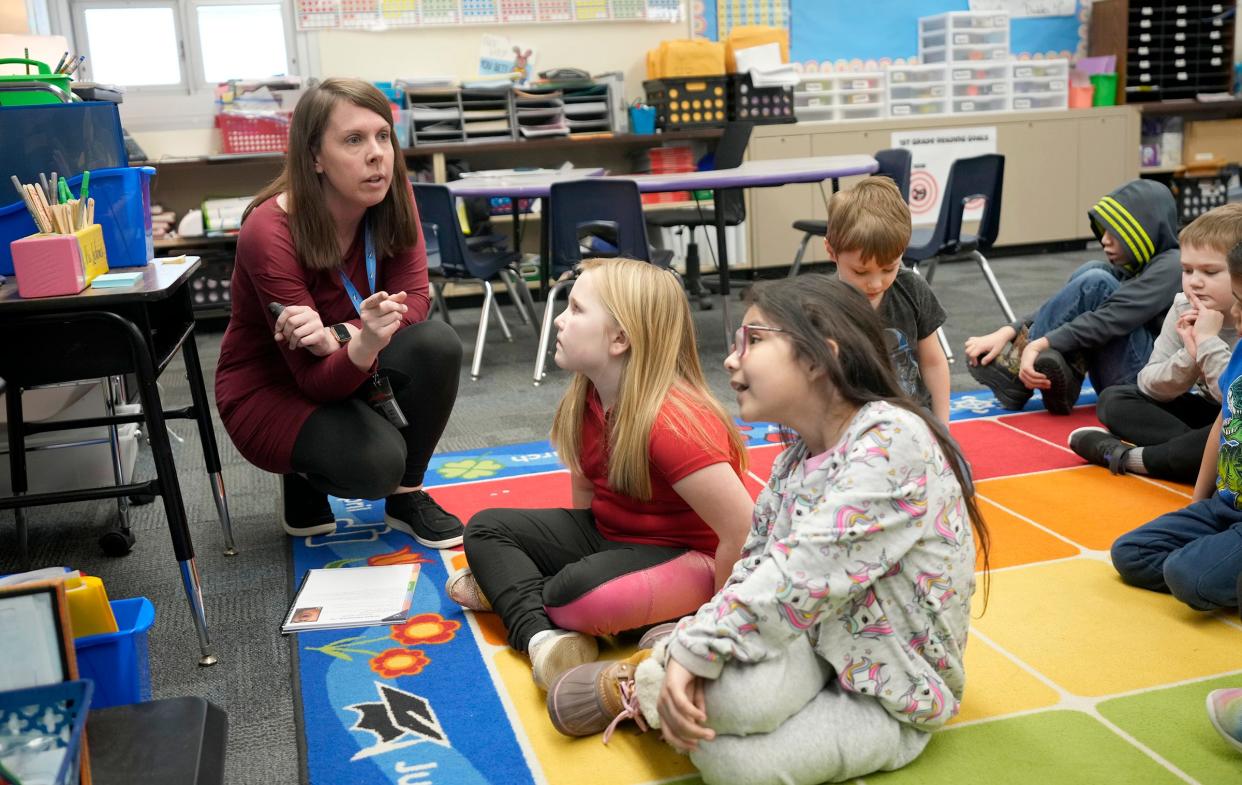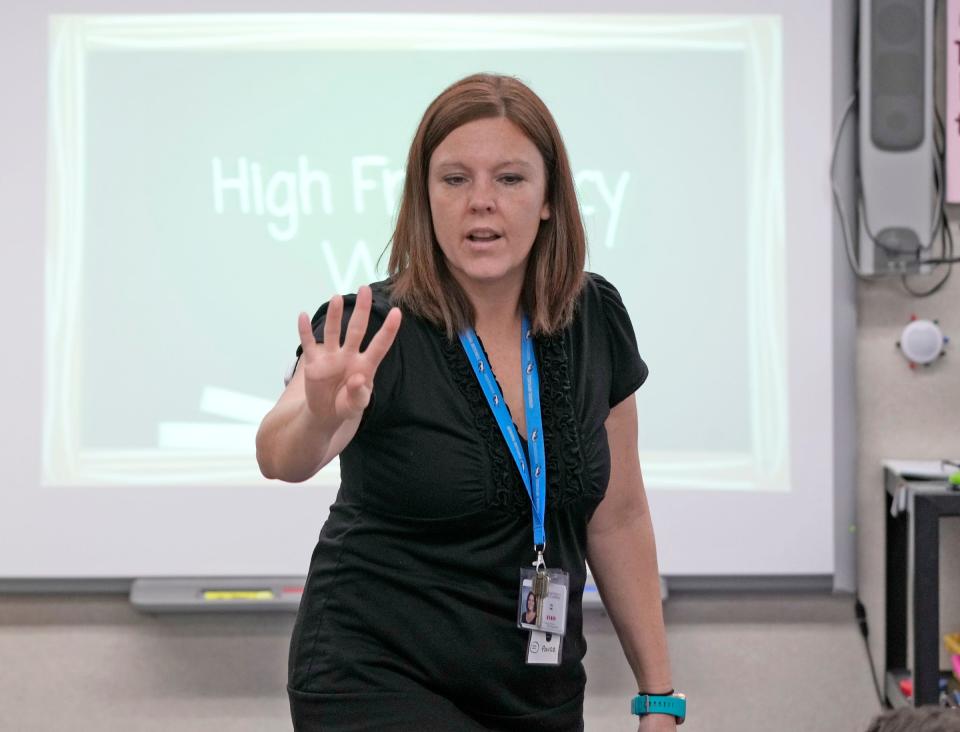Reading looks different now in Cudahy Schools, as students g-r-o-w through science of reading

A shift toward using “science of reading” curriculums that emphasize phonics in teaching students to read is occurring in Wisconsin and across the nation. This is the third of three columns describing what this means to students, educators and parents in Cudahy Public Schools, which has embraced this approach.
More: Cudahy Schools' shift to a new reading curriculum looks like it's paying off
More: Cudahy’s move to science of reading curriculum hasn’t been easy, but test scores are encouraging
While the term “science of reading” is strongly associated with emphasis on phonics and sounding out words, proponents say that is only part of a broader undertaking.
“Science of reading” is largely associated with a report two decades ago from a task force created by Congress called the National Reading Panel. The report emphasized five pillars of successful instruction in reading: phonemic awareness, phonics, fluency, vocabulary and comprehension. Each has a different technical definition. Experts associated with the science stress the importance of each. That includes comprehension — which critics argue is a weakness of strong phonics programs and a strength of balanced literacy.
If you walk into classrooms in Cudahy, you see evidence of all five pillars — and you see things being done differently than several years ago.
Then ... and now
Michael Moore, principal of Mitchell Elementary, and Julie Speidel and Jolene Rosploch, both reading specialists as the school, described what an observer would have seen then versus now.
In the past, Speidel said, you would have seen the teacher doing more of the reading to the group than you see now. The practice now emphasizes the class or small groups reading together, often with a teacher reading a passage, then the group reading together, then students reading to each other in pairs or small groups.
More: By the Book: We're investigating why many Wisconsin kids struggle to read. We want to hear from you.
In the past, Speidel said, students would be asked to take turns reading parts of a passage to the whole class. That can lead to many kids not being sufficiently engaged and to overlooking some students who are not doing well. Now, every student takes part.
Moore said that three years ago, an observer would have seen more “inconsistency” in how reading instruction was being taught from classroom to classroom — and sometimes even by the same teacher within a classroom. Greater consistency increases equity in teaching students because each student gets the same amount of participation, Moore said.
Speidel said that in the past, teachers referred low-performing students to her. She would do assessments and help individual students, but, in reality, some didn’t get the immediate and focused attention they needed. Now, she said, she works more closely with classroom teachers, and responses to students who are not making good progress come more promptly.
Rosploch said that in the past, she did not focus as much as she does now on data on each child’s work. The current approach, including a change in the assessments that schools are using for internal purposes, means that everyone pays close attention to each student’s results.
Consultants from the Colorado-based firm that Cudahy is using to launch the science of reading work are assigned to each school.

In the case of Mitchell school, the consultant, Alan Dillon, a long-time educator and former associate state commissioner of education in Colorado, is making seven in-person visits this school year.
On one visit, he and school leaders observed each of the first-grade classrooms. After each observation, the team huddled in the hallway, and Dillon described what he saw: the levels of student engagement, the degree of consistency in teaching technique, the teacher’s attention to signs that individual students were getting what was being taught (or not).
Dillon said Mitchell students are far ahead of where they were in the first year of implementation and, overall, specific goals for year-to-year improvement were being met.
Dillon praised the way aspects of the science of reading beyond phonics were being strengthened. Kids need to grow in “language acquisition,” such as vocabulary, he said. “We want kids to be engaged with quality literature,” he said.
Progress comes at a cost
The costs of the reading initiative have not been small for Cudahy. Superintendent Tina Owen-Moore said the district paid $211,750 to consulting firm Schools Cubed for work during the 2021-22 school year, money that came from the school's federal pandemic aid.
The money covered training of school leaders and staff, as well as consultant visits to observe classes.
For 2022-23, the firm is being paid $209,450 from pandemic funds and other federal aid. For next year, the last year of its contract, it is expected to receive $100,000, from non-pandemic federal money.
In addition, Cudahy has paid $102,185 for materials needed in classrooms, and it is spending $304,907 from its general revenue for new curriculum materials. Owen-Moore said the district was previously scheduled to purchase language arts and reading curriculum this year.

Will the costs of the science of reading initiative be sustainable? Owen-Moore expects so. Startup costs, such as the consulting firm, will phase out, although training staff and overseeing implementation will be continual needs. But prior programs had costs also.
How tight the budget will be in Cudahy (and all schools in the state) depends on what happens with the state budget in the next several months. The budget will shape general school revenue and perhaps include money specifically for state support of science of reading programs.
There are legislators interested in promoting the phonics-oriented work, and there is some possibility of bipartisan agreement. It appears state action, if any, would not mandate the science of reading be used statewide, but would provide incentives to do so.
Cudahy school leaders say they are committed to sticking with the change they have launched and determined to do the difficult work of making it effective.
Where will things be five years from now? Owen-Moore said she expects the science of reading will be embedded in Cudahy education and that every student will be a strong reader, with skills to pursue any path they choose. An amibitous goal? For sure. But doable? They’ll find out.
Growing good readers
Molly Hinkes, in her eighth year as a first-grade teacher at Mitchell School, said she was in favor of the revamped approach to teaching reading. “It’s working; it’s starting to click with kids,” she said. They know the expectations and routines. She is seeing a lot of growth, particularly in her students with special education needs. “It’s very rewarding to see,” she said. “We’re constantly doing what’s in the best interest of kids.”
Molly Lochemes, also in her eighth year as a first-grade teacher, said that a year ago, all of her students were in the red zone as readers. This year, the picture is multicolored: green, yellow and red.
On a recent day, Lochemes led students in tackling some words. One was “grow.”
Lochemes told the students, “Get your fingers up.” They used their fingers to count the three phonemes in the word: g, r, o (and they learned that the word ends with w, one of the thousands of exceptions to simply sounding out the letters in a word, which science of reading experts say brains can deal with well).
“What’s the word?” Lochemes asked.
“Grow,” the students answered together.
“Spell it,” she said. “G-r-o-w spells grow,” the students answered, repeating it two more times.
Through uncountable steps like that, day after day, week after week, Cudahy educators hope students are learning just that: the meaning of the word “grow. “
Alan J. Borsuk is senior fellow in law and public policy at Marquette Law School. Reach him at alan.borsuk@marquette.edu.
Our subscribers make this reporting possible. Please consider supporting local journalism by subscribing to the Journal Sentinel at jsonline.com/deal.
DOWNLOAD THE APP: Get the latest news, sports and more
This article originally appeared on Milwaukee Journal Sentinel: Cudahy Schools leaders: Cost of reading curriculum is worth investment

